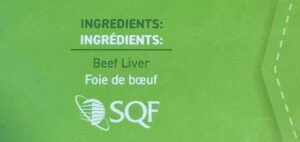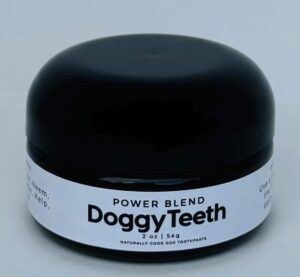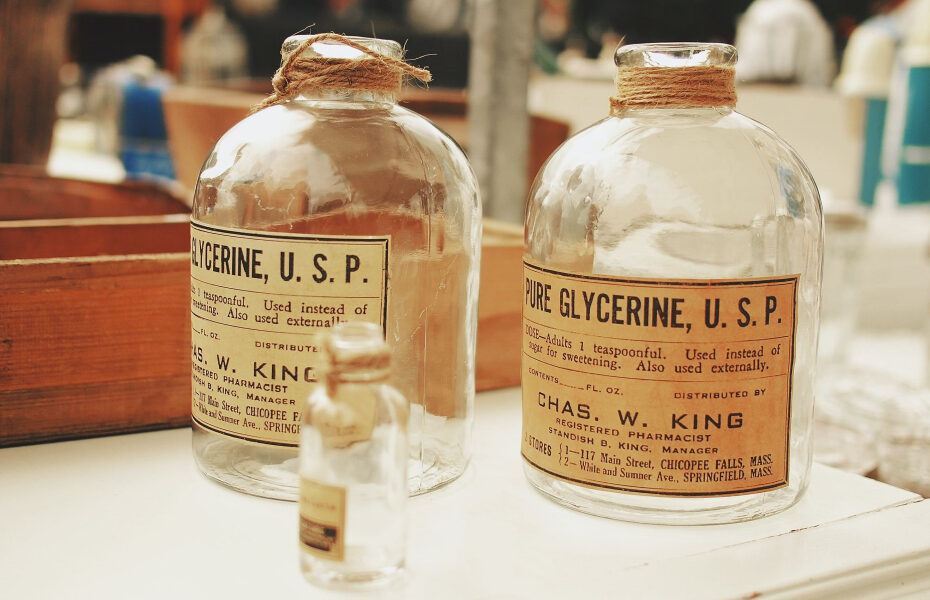Dog toothpaste without glycerine does exist and it’s a healthier choice for your dog. Given the massive amount of chemicals and additives in all of our food and personal care products it makes good sense to understand what the different ingredients are and what the best natural alternatives are so you can choose wisely.
Glycerine is everywhere in dog products. It’s used in dog shampoos, treats, and, of course, toothpaste. Many pet owners don’t really know what glycerine is or why it’s so common in these products. It’s more important now than ever to take the time to read labels and understand what the ingredients do in the products you are purchasing and consuming.
The reason glycerine is in so many dog items comes down largely to its properties and cost. Glycerine retains moisture, which helps keep products from drying out. This makes it invaluable in durable items like dog toothpaste. Beyond moisture retention, it’s also used as a solvent and sweetener. So, your dog’s toothpaste doesn’t just stay moist; it tastes better, too.
Glycerine’s cost-effectiveness makes it a desirable widespread ingredient in many products. It’s a by-product of soap and biodiesel production. This ease of availability keeps costs down while providing functional benefits. Manufacturers favor it because it’s budget-friendly and serves multiple purposes in keeping their products stable and palatable.
Not all glycerine is the same. There are two main types: animal-based and plant-based. Animal-based glycerine comes from animal fats, while plant-based is derived from vegetable oils. Plant-based glycerine is often marketed as the more sustainable choice, but its production still involves extensive industrial processes.
Manufacturers worldwide produce glycerine, but the majority comes from regions rich in soy and palm oil, significant sources for plant-based glycerine. The environmental impact of these sources is significant, contributing to deforestation and habitat destruction. On the other hand, animal-based glycerine has a different set of ethical considerations, depending on how and where it’s sourced.
Assessing the Safety of Glycerine for Dogs: Benefits and Risks
Is glycerine safe for dogs? The question pops up often among pet owners, and understanding the answer involves looking at both benefits and risks.
Glycerine is technically safe for dogs when used in small amounts. It’s regarded as non-toxic, and many dogs consume it regularly without immediate issues. It helps keep their toothpaste palatable and their treats moist. However, problems can start when dogs ingest too much of it. So if you can minimize the amount of glycerine your dog is consuming by using a dog toothpaste without glycerine you’re ahead of the game.
Excessive glycerine can lead to gastrointestinal problems like vomiting and diarrhea. Some dogs might even experience more severe symptoms, though these cases are rarer. Always consider your dog’s size and health status when it comes to glycerine intake. Smaller breeds or dogs with sensitive stomachs may react more adversely. Glycerine will have more of an impact on your dog depending on the full amount that they are ingesting so take time to read the labels on their regular dog food and especially their treats. You may be surprised at how many ingredients are contained that don’t seem natural. I’ve found my two favorite treats for my dog are freeze dried beef liver and freeze dried beef strips. The only ingredient in them is beef and beef liver.

Plant-based glycerine, derived from non-GMO sources, is typically less harmful but still carries risks, especially if not used in moderation. Additionally, the sustainability of plant-based glycerine is up for debate. Production processes can be extensive and environmentally damaging, questioning its eco-friendly reputation.
In light of these risks, it might be a better idea to steer clear of glycerine when possible. Switching to products with natural, unrefined ingredients can help sidestep potential health issues. Alternatives like tallow, which we’ll discuss later, offer similar benefits without the same level of risk.
The Superiority of Natural Ingredients: Tallow as an Emollient in Dog Toothpaste
When considering alternatives to glycerine, tallow stands out as an excellent option for dog toothpaste. Tallow, a rendered form of beef or mutton fat, is a natural ingredient that offers numerous benefits.
Tallow serves as a superior emollient compared to glycerine. Its rich, fatty composition moisturizes without synthetic additives. This makes it particularly suitable for dogs with sensitive gums and teeth. Using tallow is the best natural choice and it tastes great.
Sustainability is another advantage. Tallow is a by-product of the meat industry, making use of parts that might otherwise go to waste. This contrasts with the environmental challenges posed by the production of plant-based glycerine, like deforestation and intensive cultivation.
The emollient properties of tallow also help protect your dog’s oral health. It creates a natural barrier that shields teeth and gums from harmful bacteria and plaque buildup. The absence of chemical additives means fewer chances for adverse reactions, making it safer for regular use.
Using tallow in dog toothpaste aligns with a preference for unrefined, natural ingredients. It avoids the artificial elements that can sometimes cause health issues, providing a more straightforward, healthier choice for your pet.
Incorporating tallow-based toothpaste into your dog’s routine can significantly improve their oral hygiene. Not only does it offer better moisture retention and protection, but it also reduces the risk of gastrointestinal issues linked to glycerine.
Creating a Better Dog Toothpaste Without Glycerine: Ingredients and Best Practices
Choosing the right ingredients for your dog’s toothpaste is more crucial than it might seem. Ingredients impact not just the efficacy but also the safety of the product. Always prioritize natural, unrefined components over synthetic additives.

The DoggyTeeth Power Blend has four simple natural ingredients. It’s an effective fusion of grass-fed beef tallow, organic kelp, organic olive leaf and neem bark. Tallow is great for its moisturizing and protective properties and the fact that is that it’s a true food product that has an irresistible taste to your dog so it’s easy to brush their teeth.
Reading labels effectively is essential when choosing a commercial product. Look for clear ingredient lists and avoid items with vague terms like ‘flavoring’ or ‘preservatives.’ Artificial flavours are a chemical concoction. According the EWG “Flavors are complex mixtures that sometimes comprise more than 100 chemicals”. Remember a transparent label often indicates a better-quality healthier product.
Sticking to natural and unrefined ingredients is better for your dog’s health. They reduce the risk of adverse reactions and provide a cleaner, more effective approach to oral hygiene. Opting for products made with tallow and other wholesome components can make a noticeable difference in your dog’s dental health and overall wellness.
